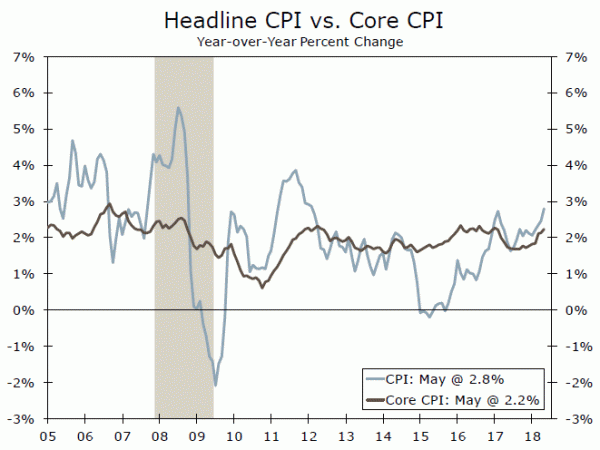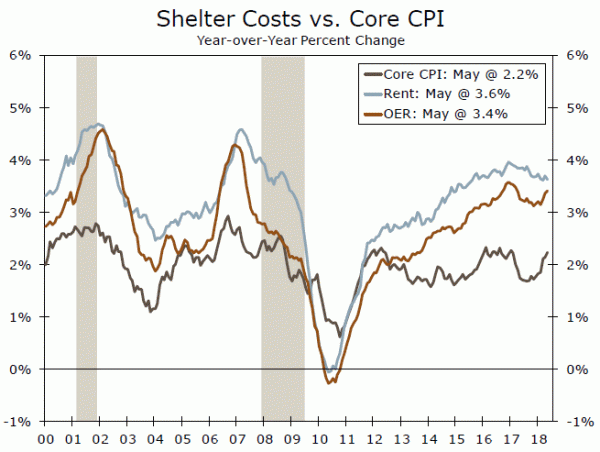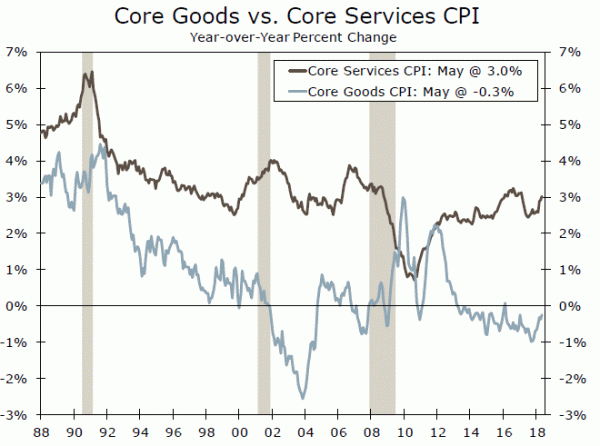The CPI advanced 0.2 percent in May, helped by a rise in energy costs and core services. Over the past year, the CPI is up 2.8 percent and the core is running at 2.2 percent—roughly consistent with the Fed’s target.
Energy and Core Services Drive Inflation Higher
Consumer price inflation continues to gradually pick up. Headline and core CPI rose a matching 0.2 percent in May and on a 12-month basis are both advancing at the fastest pace in at least a year.
As expected, a jump in gasoline prices lifted the index in May. Although prices at the pump typically rise this time of year, as the summer driving season kicks off, the recent run was particularly swift, leading to a 1.7 percent rise after seasonal adjustment. A pullback in energy services, however, kept the overall increase in energy costs more restrained at 0.9 percent. We expect the contribution from energy to be more muted in the coming months, as oil prices ease.
Food prices were unchanged in May, with a decline in the food at home category offset by a further advance in food away from home. Despite this month’s softness, food should be more supportive of inflation later this year, as related commodity prices are modestly higher and labor costs are rising for restaurants and grocery stores.
Higher core inflation continues to be driven by the service sector. Services ex-food and energy rose 0.3 percent in May amid another solid increase in shelter costs. While primary rent growth softened and is beginning to be weighed down by the onslaught of new apartment construction, lodging away from home bounced back (+2.9 percent) and owners’ equivalent rent continues to advance amid tight for-sale inventories. In contrast, core goods prices edged down 0.1 percent for a third consecutive month; a drop in household furnishings and used autos more than offset a 1.4 percent jump in prescription drugs.
Upward Trend Sufficient for Further Fed Hikes
May’s advance in CPI brings the year-ago rate up to 2.8 percent from 2.5 percent in April. While energy has been a significant driver of the pickup—contributing 0.9 percentage point to the 12-month change—the core index confirms the underlying trend in inflation is also moving higher. At 2.2 percent, core inflation is rising at the fastest pace since January 2017.
The latest ISM and NFIB surveys illustrate companies are increasingly contending with rising costs for materials and labor. While average hourly earnings growth has picked up only modestly, wage pressures are building in what has become an increasingly tight labor market. We do not believe we need to see earnings growth strengthen in order to see more inflation. Inflation tends to lead earnings, not the other way around, as businesses try to get ahead of rising input costs. Therefore, we expect to see core CPI continue to run a bit above 2 percent in the coming months. Core PCE, which is more closely watched by the Fed, should also move higher, reaching the FOMC’s target of 2.0 percent as soon as the third quarter. That should pave the way for the Fed to raise rates not only at the end of tomorrow’s meeting, but twice more in the second half of the year.















